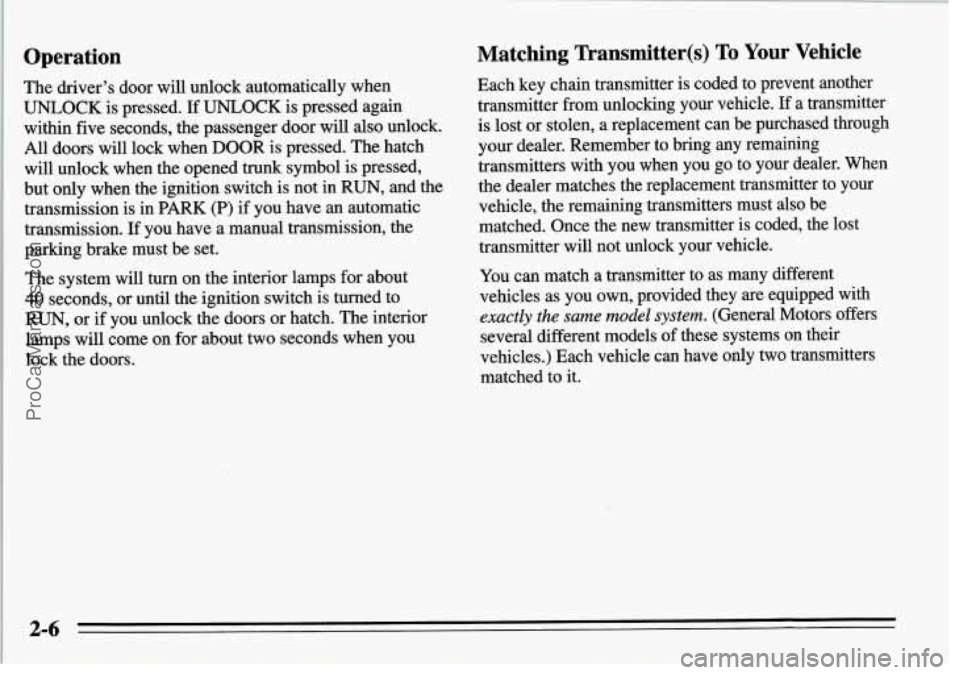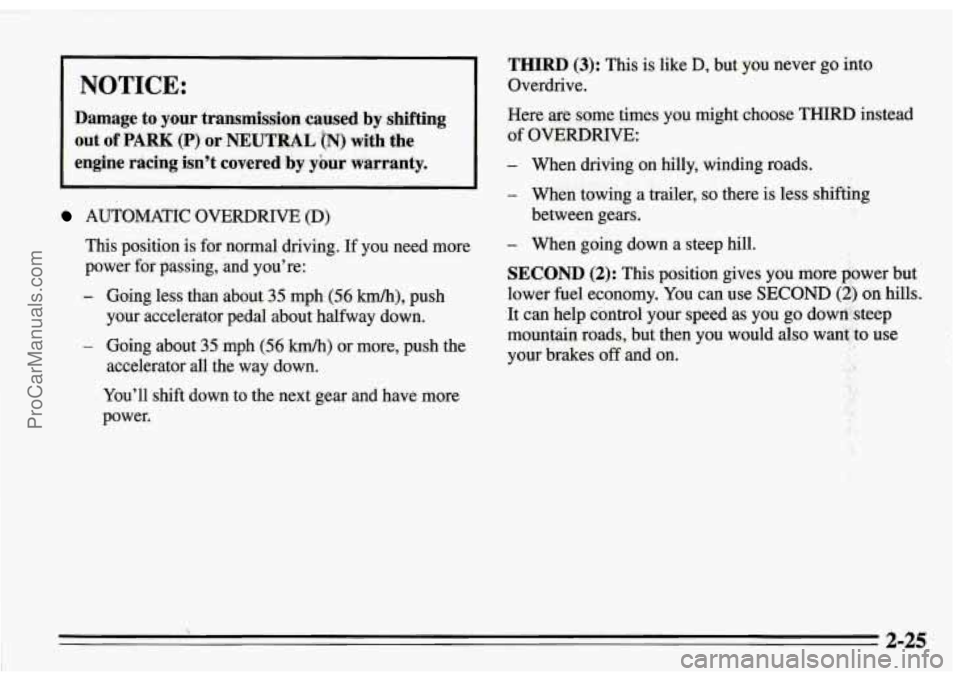automatic transmission PONTIAC FIREBIRD 1995 Owners Manual
[x] Cancel search | Manufacturer: PONTIAC, Model Year: 1995, Model line: FIREBIRD, Model: PONTIAC FIREBIRD 1995Pages: 386, PDF Size: 19.66 MB
Page 53 of 386

Operation
The driver’s door will unlock automatically when
UNLOCK is pressed. If UNLOCK is pressed again
within five seconds, the passenger door will
also unlock.
All doors will lock when DOOR is pressed. The hatch
will unlock when the opened
trunk symbol is pressed,
but only when the ignition switch is not in
RUN, and the
transmission is in
PARK (P) if you have an automatic
transmission.
If you have a manual transmission, the
parking brake must be set.
The system will turn on the interior lamps for about
40 seconds, or until the ignition switch is turned to
RUN,
or if you unlock the doors or hatch. The interior
lamps will come on for about two seconds when you
lock the doors.
Matching Transmitter(s) To Your Vehicle
Each key chain transmitter is coded to prevent another
transmitter from unlocking your vehicle.
If a transmitter
is lost or stolen, a replacement can be purchased through
your dealer. Remember to bring any remaining
transmitters with you when you
go to your dealer. When
the dealer matches the replacement transmitter to your
vehicle, the remaining transmitters must also be
matched. Once the new transmitter is coded, the lost
transmitter
will not unlock your vehicle.
You can match a transmitter to as many different
vehicles as you own, provided they are equipped with
exactly the same model system. (General Motors offers
several different models of these systems on their
vehicles.) Each vehicle can have only two transmitters
matched to
it.
2-6
ProCarManuals.com
Page 61 of 386

New Vehicle “Break-In” Ignition Switch
NOTICE:
Your modern Pontiac doesn’t need an elaborate
%break-in.” But it
will perform better in the long
run
if you follow these guidelines:
0
0
0
0
Keep your speed at 55 mph (88 km@) or
less for the first
500 miles (804 km).
Don’t drive at any one speed
-- fast or slow
-- for the first 500 miles (804 km). Don’t
make full-throttle starts.
Ayoid making hard stops for the first
2a0: miles (322 kni) or so. During this time
your new brake linings aren’t yet broken
in. Hard stops with new linings can mean
premature wear and earlier replacement.
Follow this “breaking-in” guideline every
time you get new brake linings.
Don’t tow a trailer during “break-in.” See
“Towing a Trailer” in the Index for more
information.
With the ignition key in the ignition switch, you can turn
the switch to five positions:
ACC (A): Position in which you can operate your
electrical power accessories. Press in the ignition switch as you
turn the top of it toward you.
LOCK (B): The only position in which you can remove
the key. This locks your steering wheel, ignition and
automatic transmission.
2-14
ProCarManuals.com
Page 62 of 386

If you have an automatic transmission, the ignition
switch can’t be turned to
LOCK unless the shift lever is
in the PARK (P) position.
OFF (C): Unlocks the steering wheel, ignition and
automatic transmission, but does not send electrical
power to
any accessories. Use this position if your
vehicle must be pushed or towed.
A warning tone will
sound if you open the driver’s door when the ignition is
OFF and the key is in the ignition.
RUN (D): Position to which the switch returns after you
start your engine and release the switch. The switch
stays in the
RUN position when the engine is running.
But even when the engine is not running, you can use
RUN to operate your electrical power accessories and to
display some instrument panel warning and indicator
lights.
START (E): Starts the engine. When the engine starts,
release the key. The ignition switch will return to
RUN
for normal driving.
Note that even if the engine is not running, ACC and
RUN allow you to operate your electrical accessories,
such as the radio and ventilation fan.
Key Release Button: If you have a manual
transmission, your ignition lock has
a key release button.
You must press the button before you can take: your key
out
of the ignition lock.
2-15
ProCarManuals.com
Page 64 of 386

Starting Your Engine
Engines start differently. The 8th digit of your Vehicle
Identification Number
(VIN) shows the code letter or
number for your engine. You will fiid the
VIN at the top
left of your instrument panel. (See “Vehicle
Identification Number”
in the Index.) Follow the proper
steps to start the engine.
Automatic transmission:
Move your shift lever to PARK (P) or NEUTRAL (N).
Your engine won’t start in any other position -- that’s a
safety feature.
To restart when you’re already moving,
use NEUTRAL (N)
only.
NOTICE:
Don’t try to shift to PARK (P) if your Pontiac is
moving. If you do, you could damage the
transmission. Shift to
PARK (P) only when your
vehicle
is stopped.
Manual transmission:
The gear selector should be in neutral. Hold the clutch
pedal to the
floor and start the engine. Your vehicle
won’t
start if the clutch pedal is not all the way down --
that’s a safety feature.
To start your V6 engine:
1. Without pushing the accelerator pedal, turn your
ignition key to START. When the engine starts, let
go of the key. The idle speed
will go down as your‘
engine gets warm.
NOTICE:
Holding your key in START for longer thh
15 seconds at a time will cause your battery to
be drained much sooner. And the excessive. heat
can damage your starter motor.
’ 2-17
ProCarManuals.com
Page 70 of 386

Automatic Transmission
There are several different positions for your shift lever.
PARK (P): This locks your rear wheels. It’s the best
position to use when you start your engine because your
vehicle can’t move easily.
2-23
ProCarManuals.com
Page 72 of 386

NOTICE:
THIRD (3): This is like D, but you never go into
Overdrive.
Damage to your transmission caused by shifting Here are some times you might choose THIRD instead
out of PARK (P) or NEUTRAL [N) with the of OVERDRIVE:
engine racing isn’t covered by your warranty. - When driving on hilly, winding roads.
- When towing a trailer, so there is less shifting
AUTOMATIC OVERDWE (D) between gears.
This position is for normal driving. If you need more
power for passing,
and you’re:
- Going less than about 35 mph (56 kmk), push
your accelerator pedal about halfway down.
- Going about 35 mph (56 kmk) or more, push the
accelerator all the way down.
You’ll shift down to the next gear and have more
power.
- When going down a steep hill.
SECOND (2): This position gives you more power but
lower fuel economy.
You can use SECOND (2) on hills.
It can help control your speed as you go dowri-:.steep
mountain roads, but then you would also want-to use
’,
your brakes off and on.
4
!
1
I
ProCarManuals.com
Page 82 of 386

2. Move the shift lever into PARK (P) position like
this:
Hold in the button on the lever, and push the
lever all the way toward the front of your car.
3. Move the ignition key to LOCK.
4. Remove the key and take it with you. If you can
walk away from your car with the ignition key in
your hand, your car
is in PARK (P).
Leaving Your Vehicle With the Engine
Running (Automatic Transmission Models
Only)
If you have to leave your vehicle with the engine
running, be sure your vehicle is in PARK (P) and your
parking brake is firmly set before you leave it. After
you’ve moved the shift lever into the PARK (P)
position, hold the regular brake pedal down. Then, see if
you can move the shift lever away from PARK (P)
without first pushing the button. If you can, it means
that the shift lever wasn’t fully locked into PARK
(P).
Torque Lock (Automatic Transmission)
If you are parking on a hill and you don’t shift your
transmission into PARK (P) properly, the weight of the
vehicle may put too much force on the parking pawl in
the transmission. You may find it difficult to pull the
shift lever out of PARK (P). This is called “torque lock.”
To prevent torque lock, set the parking brake and then
shift into PARK
(P) properly before you leave the
driver’s seat. To find out how, see “Shifting Into
PARK
(P)” in the Index.
When you are ready to drive, move the shift lever out of
PARK (P)
before you release the parking brake.
If “torque lock” does occur, you may need to have
another vehicle push
yours a little uphill to take some of
the pressure from the transmission,
so you can pull the
shift lever out of PARK (P).
2-35
ProCarManuals.com
Page 83 of 386

Shiftiqg out of PARK (P)
(Authmatic .. .. Transmission)
Parking Your Vehicle
(Manual Transmission)
Your Pontic has a brake-transmission shift interlock. Before you get out of your vehicle, put your manual
You hqve to hlly apply your regular brake before you transmission in REVERSE (R) and firmly apply the
ca~ shjft from PARK (P) when the ignition is in the parking brake.
RUN position. See “Automatic Transmission” in the
Index.
If yov cmot shift out of PARK (P), ease pressure on
the shift lever - push the shift lever all the way into
PARK (P) and release the shift lever button as you
maintain brake application. Then press the shift lever
button
and move the shift lever into the gear you wish.
If you per hold the brake pedal down but still can’t
shift out
of PARK (P), try this:
1. Turn @e key to OFF.
If your vehicle is equipped to tow a trailer, see “Towing
a Trailer” in the Index.
2, Apply and hold the brake.
3. Shift to NEUTRAL (N).
4. St& the vehicle and then shift to the drive gear you
5. Have the vehicle fixed as soon as you can,
ww!.
ProCarManuals.com
Page 85 of 386

Running Your Engine While You’re
Parked (Automatic Transmission)
It’s better not to park with the engine running. But if you
ever have to, here are some things to know.
Follow the proper steps to be sure your vehicle won’t
move. See “Shifting Into
PARK (P)” in the Index.
If you are parking on a hill and if you’re pulling a
trailer, also see “Towing a Trailer” in the Index.
2-38
ProCarManuals.com
Page 92 of 386

Cruise Control (Option)
With cruise control, you can maintain a speed of about
25 rnph (40 km/h) or more without keeping your foot on the
accelerator.
This can really help on long trips. Cruise control
does not work at speeds below about
25 mph (40 km/h).
When you apply your brakes, or push the clutch pedal,
if you have a manual transmission, the cruise control
shuts
off.
If your vehicle is in cruise control when the optional
traction control system begins to limit wheel spin,
the cruise control will automatically disengage. (See
“Traction Control” in the Index.) When road conditions
allow you to safely use it again, you may
turn the cruise
back on.
2-45
ProCarManuals.com